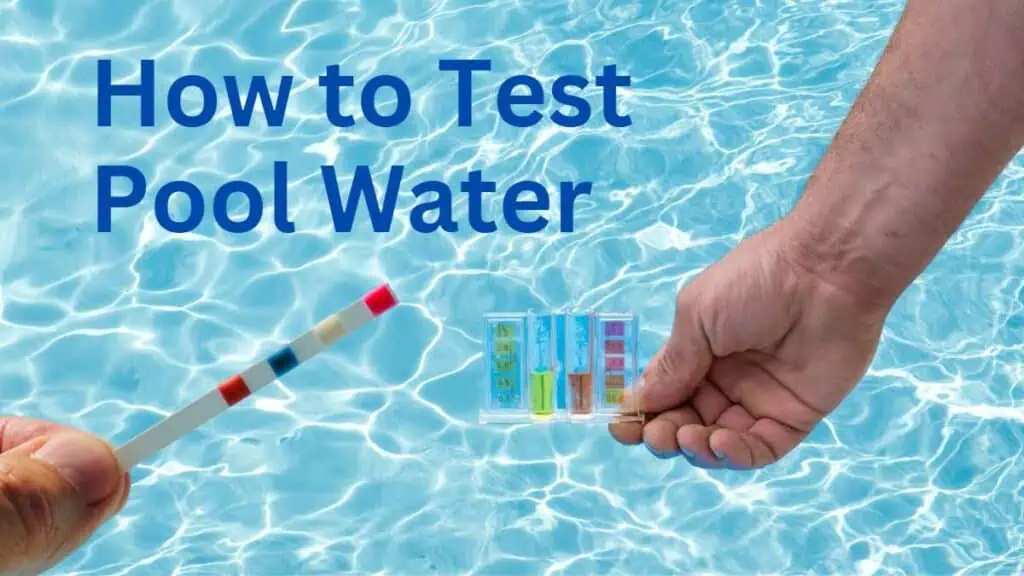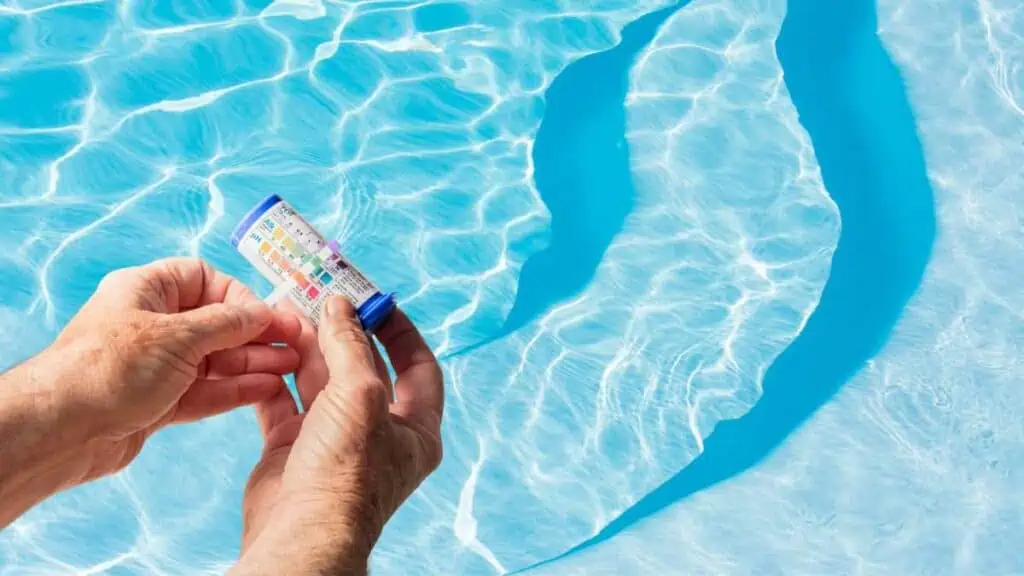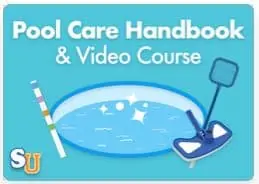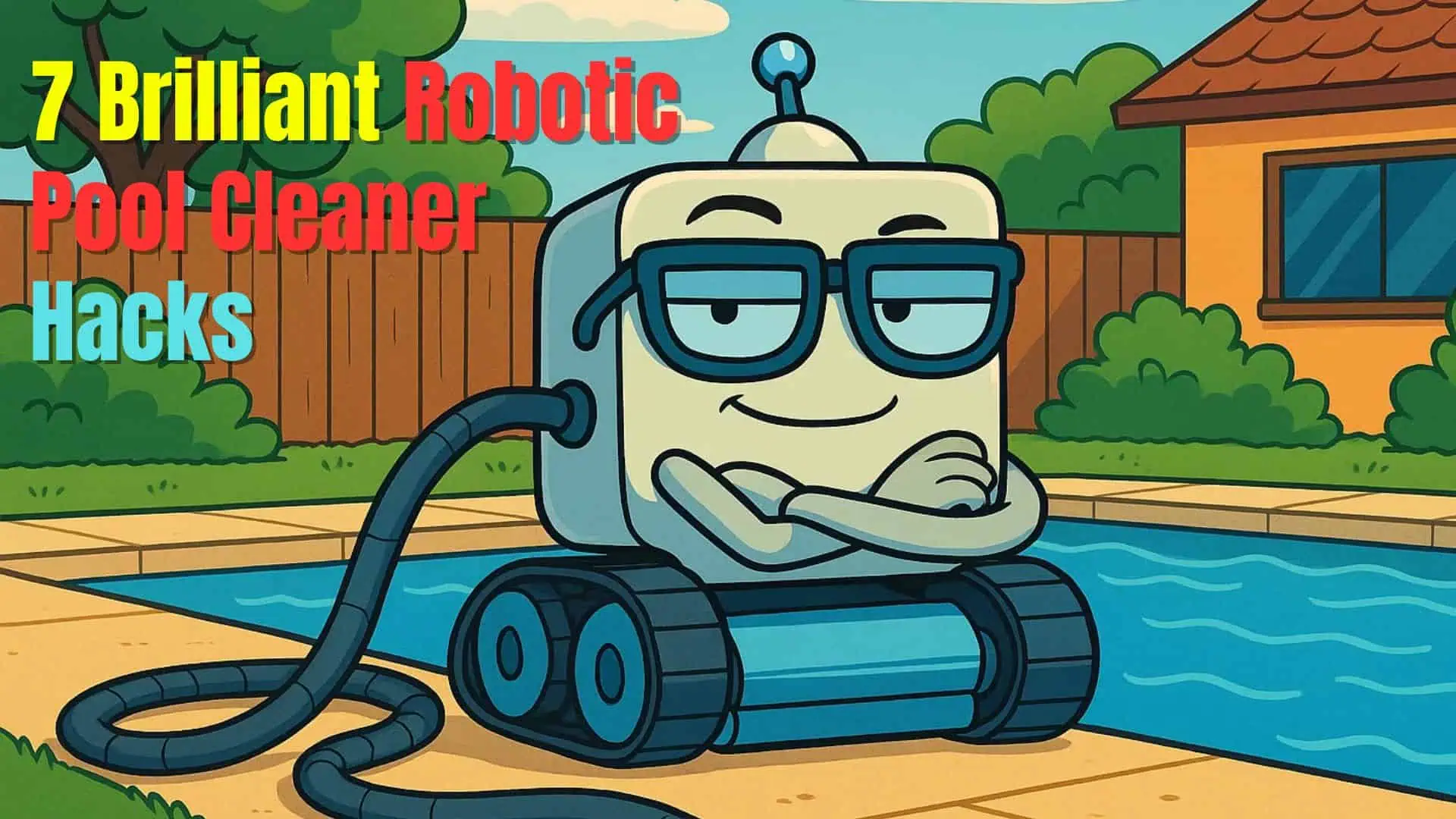Testing pool water is essential to maintaining a healthy and enjoyable swimming environment. By regularly monitoring your pool’s chemical balance, you can protect it and the swimmers in it.
Various testing kits simplify this process, and in this article, we’ll guide you through the steps to test your pool water accurately. You’ll learn how to test pool water using different testing methods and important aspects to keep track of for optimal water quality.


Importance of Testing Pool Water
Testing your pool water ensures a clean and safe swimming environment. By regularly monitoring the water chemistry, you can maintain crystal-clear water free from algae and harmful microorganisms.
Proper chemical balance prevents potential damage to your pool and its equipment. Imbalanced water chemistry could lead to costly repairs and shorten the lifespan of your pool system.
Another important aspect of testing pool water is protecting swimmers’ health. Unbalanced water can cause skin irritation, red eyes, or other health issues. Moreover, it informs you about the level of sanitizers, which are essential to kill bacteria and other contaminants in the water.
Regular pool water testing allows you to add the required chemicals, avoiding over-treatment or under-treatment precisely. It ultimately saves you money, ensuring you only use the necessary products to maintain proper balance.
Lastly, testing pool water is essential to complying with local regulations and pool safety standards and creating a pleasant experience for everyone who uses your pool.
Types of Pool Water Tests
When testing your pool water, it’s essential to choose the right method for your needs. In this section, we’ll explore three types of pool water tests: test strips, liquid test kits, and digital testers.
Test Strips
Test strips are a popular and cost-effective method for testing pool water. They are fast, easy to use, and provide fairly accurate results. To use test strips, dip them into your pool water and compare the color change to the chart provided.
General test strips check for primary components like pH, alkalinity, and chlorine levels. However, specialty strips can measure additional factors such as copper, iron, and salt. Using these strips helps maintain the ideal water balance in your pool.
Recommended Test Strips
Liquid Test Kits
Liquid test kits are another option for testing your pool’s water quality. They usually include reagents, such as OTO (orthotolidine) and phenol red, to measure chlorine and pH levels in the pool water.
To use a liquid test kit, you’ll need to collect a water sample in the provided container, add the appropriate reagents (typically 4 to 5 drops of each), then shake and observe the color change. Comparing the resulting color with the kit’s provided chart will give you an accurate reading of your pool water’s chemical levels.
Recommended Test Kit
Digital Testers
Digital testers offer a more advanced and accurate method for measuring the quality of your pool water. These devices take the guesswork out of color matching by providing an exact digital readout of various chemical levels.
While digital testers may have a higher upfront cost, their precision and ease of use can save you time and potentially prevent issues caused by improper water balance. Follow the manufacturer’s instructions and immerse the digital probe into the pool water to obtain the necessary readings.
Recommended Digital Tester
How to Test Pool Water without a Kit
Pool supply stores will, in most cases, test pool water using their analysis equipment for free. You just take a pool water sample and receive a printout showing the readings. They will recommend what you need to add to correct any off readings.
Remember that they offer the service free because they want to supply you with chemicals.
Key Parameters to Test
When testing your pool water, several key parameters must be measured to ensure a safe and enjoyable swimming experience.
Understanding these parameters can help you maintain the proper balance of chemicals in your pool.
| Key Parameter | Ideal Level |
|---|---|
| pH Level | 7.4-7.6 |
| Chlorine | 1-3 ppm |
| Total Alkalinity | 80-120 ppm |
| Calcium Hardness | 200-400 ppm |
| Stabilizer (CYA) | 30-50 ppm |
| Salt Content | 3,000 ppm |
pH Level
The first parameter to test is the pH level, which measures how acidic or basic your pool water is. A proper pH level is essential for your pool’s sanitizing chemicals to work effectively. Ideally, you should aim for a pH level between 7.4 and 7.6.
Chlorine
Chlorine is a crucial factor in maintaining the cleanliness of your pool. It acts as a sanitizer, eliminating harmful bacteria and algae growth. Ensure that your free chlorine levels are between 1 and 3 ppm (parts per million).
Total Alkalinity
Total alkalinity keeps the pool’s pH level stable. Test for this parameter to maintain a balanced system and prevent sudden fluctuations. The ideal level of total alkalinity is between 80 and 120 ppm.
Calcium Hardness
Testing for calcium hardness is essential to prevent scaling or corrosion in your pool. A balanced calcium level ensures the pool surface and equipment remain in good condition. Keep calcium hardness levels between 200 and 400 ppm.
Stabilizer (Cyanuric Acid)
Cyanuric acid, a stabilizer, helps protect chlorine from being rapidly depleted by sunlight. It’s important to test for cyanuric acid regularly, especially in outdoor pools. Aim for levels between 30 and 50 ppm.
Salt Content
Monitoring the salt content is vital if your pool uses a saltwater system. Optimizing salt levels allows the saltwater generator to produce the correct amount of chlorine. Maintain a salt content of approximately 3,000 ppm.
How to Test Pool Water with Test Strips

Testing your pool water with test strips is quite simple and efficient. First, with clean, dry hands, remove a single strip from the container and ensure the container is closed tightly afterward.
Next, dip the test strip into your pool water at elbow depth, away from any jets, and submerge it for 15 seconds. Once the time is up, remove the strip from the water without shaking it off.
Then, place the wet strip on a level surface and compare its colors to the chart provided on the package. This comparison will help you determine the chemical balance of your pool water and guide you in making any necessary adjustments.
How to Test Pool Water with Liquid Test Kits

First, gather your liquid test kit and a clean cup to collect the pool water. Ensure your hands are clean and dry before handling the test kit components to avoid contamination.
Submerge the collection cup into the pool water, lowering your arm until the water reaches your elbow, about 12 to 18 inches deep. Flip the cup over to collect the water sample, and once you have the sample, fill the large tube in the test kit to the top solid line.
Add the required testing chemicals to the water samples according to the kit’s instructions. This typically includes OTO (orthotolidine) for measuring chlorine levels and phenol red for measuring pH levels. Add the recommended number of drops to the sample and gently swirl the tube to mix the solutions.
Once the samples have been properly mixed, check the color of the water sample against the color chart provided with your test kit. This will give you an accurate reading of your pool’s chlorine and pH levels. Keep track of these results to maintain a healthy swimming environment.
Be sure to test your pool water at least once a week to ensure it stays balanced and safe for swimming. By following these steps, you can confidently maintain your pool water chemistry and keep your pool in excellent condition.
How to Test with Digital Pool Water Tester
Before testing your pool water, circulate it on your pump’s high setting for at least an hour. That way, you’ll get an accurate sample. When ready, gather your water sample from about 12-18 inches below the surface, avoiding areas near returns or floating chemical dispensers.
Now, grab your digital pool water tester and fill the vials with water from your swimming pool. Add the appropriate amount of reagent drops, as specified in your digital tester’s instructions. For most digital testers, five drops of reagent should suffice, but always remember to consult your specific tester’s guidelines.
Once you’ve added the reagent to the vial, insert the vial into your digital tester and press the start button. Get ready to view the results on the easy-to-read digital display. Digital testers are known for providing accurate results, so you can confidently analyze your water’s chemical levels and adjust them as needed for safe and enjoyable swimming.
Interpreting Test Results
Test your pool water regularly (e.g., once a week) to monitor and maintain the proper chemical levels for a healthy and enjoyable swimming experience.
After testing your pool water with a test kit, it’s important to understand the results to maintain balanced water chemistry. Here’s how to interpret the main parameters of pool chemistry:
- pH level: Aim for a pH level between 7.2 and 7.8. A level below 7.2 may irritate your skin and eyes, while a level above 7.8 can lead to cloudy water and reduced chlorine effectiveness.
- Total alkalinity: The ideal range is 80-120 ppm. This helps stabilize pH levels, preventing major fluctuations damaging pool surfaces.
- Free chlorine: The ideal free chlorine concentration is 1-3 ppm. This ensures sufficient chlorine to disinfect the water yet not too much to cause skin and eye irritation.
- Calcium hardness: Aim for 200-400 ppm for calcium hardness, which helps prevent scaling and corrosion of pool equipment.
- Cyanuric acid: For outdoor pools, keep cyanuric acid levels at 30-50 ppm, as this protects chlorine from being rapidly depleted by the sun’s UV rays.
When you have your test results, compare them to the above ideal ranges. If the levels are outside the suggested ranges, you must adjust your pool chemicals to bring the water back into balance.
If you need to make adjustments, the following articles on this site will help should you need to Raise pH, Lower pH, Raise Alkalinity, Lower Alkalinity, Add Chlorine, Lower Chlorine, Add Cyanuric Acid
Test Frequency and Record Keeping
To maintain your pool’s health, test the water at least once a week. Consistency is essential, so pick a day that works best for you and stick to it. Consider testing more frequently if your pool receives heavy use or faces significant weather changes.
Record your pool’s chemical levels in a logbook or a digital tool. Doing so provides valuable data that can help you identify trends and potential issues. Include information like:
- Date and time of the test
- Temperature and weather conditions
- pH, alkalinity, and sanitizer levels
- Any chemical adjustments made
By keeping accurate records, you can ensure your pool stays in top condition and catch any imbalances before they become problematic. Proper record-keeping also aids in troubleshooting issues and provides valuable documentation should you ever need it.
Conclusion
By now, you should have a solid understanding of how to test your pool water. Remember to frequently test the key components such as free chlorine, pH, and alkalinity levels while incorporating monthly or occasional tests for factors like calcium hardness, phosphates, and metals.
Choosing between test strips, liquid testing kits, or digital testing kits is a matter of personal preference, but ensuring accuracy and ease of use will be essential for maintaining crystal-clear pool water. To prevent contamination, be mindful of your pool’s skimmer and return jets when collecting water samples.
With a diligent testing routine and promptly addressing any imbalances, you’ll save time and money in the long run while enjoying a clean, healthy swimming pool environment for you and your loved ones.









Leave a Reply